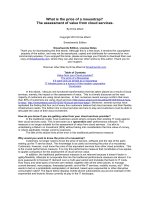Change One Thing Discover What''''s Holding You Back and Fix It With the Secrets of a Top Executive Image Consultant_5 doc
Bạn đang xem bản rút gọn của tài liệu. Xem và tải ngay bản đầy đủ của tài liệu tại đây (318.29 KB, 23 trang )
124
change one Thing
Nasal talkers.
Y
Studies have shown that most people are
annoyed by those who have a nasal quality to their voices and
sound as if they have a perpetual cold. Nasal speakers come off as
demanding and calculating, and therefore as less professional.
Quick‑fix change: Look at yourself in the mirror to see if
you are opening your mouth wide when you speak. If you aren’t
using the muscles in your mouth, practice by exaggerating the
mouth movements a bit more as you talk, so the sound waves
come from your voice box instead of from your nose.
Gravelly voice.
Y
People who have gravelly voices give off an
air of authority and experience. Gravelly talkers are often well
liked by their coworkers, and singers often cultivate this sound
in order to give their voices a more soulful, edgy quality.
Quick‑fix change: I’m not suggesting you take up smoking
cigarettes in order to sound like Lauren Bacall or Janis Joplin. In
fact, if you find that your voice is getting increasingly gravelly,
see your doctor to rule out some kind of health or throat prob-
lem. If you are a smoker, you know what you should do.
Fast talkers.
Y
Fast talkers are sometimes thought to be ner-
vous and flighty—not particularly good qualities to have attrib-
uted to you in the workplace.
Quick‑fix change:
As I mentioned earlier, pause between
sentences by taking a deep breath before you speak. This will give
you time to compose your thoughts and will allow your cowork-
ers to jump in, should they want to get a word in edgewise.
Low talkers.
Y
One of the funniest “Seinfeld” episodes was
about a low talker who asked Jerry to wear one of the puffy
shirts she designed for his appearance on the “Tonight Show.”
He unwittingly agreed because he couldn’t hear what she was
can You hear Me noW?
125
saying! You don’t want people to have to work so hard to hear
you, and low talkers come across as being meek or shy. Con-
versely, low talkers who have a deep, powerful tone to their voice
(think Paul Robeson) can exude strength and confidence. In
other words, you can speak softly if your voice carries a big stick.
Otherwise, you’ll want to work on it.
Quick‑fix change: To make sure you are being heard when
you speak, check for visual clues from the people you are talk-
ing to. If they are nodding their heads blankly, chances are they
haven’t heard a word you’ve said. To get a feel for what it sounds
like to project, practice by speaking to a friend who is standing
across the room. Do this until you feel comfortable with raising
your voice. It’s probably a good idea to avoid talking to older
folks with hearing aids until you master this.
Sloppy Speech Habits
In addition to the tone of your voice, you must also pay atten-
tion to what you are saying. Even those with the most melliflu-
ous speech can make someone cringe by being a sloppy speaker.
Here are some common mistakes to look out for:
Hemming and hawing.
Y
Fillers such as um, ah, OK, you know,
and like are the brain’s way of taking a nap. If you need to pause
to get your thoughts together, it’s better to say nothing at all
than to hem and haw like a teenager.
Slang.
Y
You don’t always have to sound like a college professor,
but using too much slang can be a verbal crutch. Once in a while
is fine, but not so that every sentence is “your bad.”
126
change one Thing
Bad grammar.
Y
Bad grammar, like bad spelling, can make you
appear, well, dumb, so bone up on your grammar by reading
more and paying attention to those who speak well. Some com-
mon mistakes:
Incorrect: “Me and my friend went to the store.”
Correct: “My friend and I went to the store.”
Incorrect: “There are a myriad of problems with this
report.”
Correct: “There are myriad problems with this report.”
Incorrect: “There were less people at the event than I
thought.”
Correct: “There were fewer people at the event than I
thought.”
Incorrect: “So I says to him, ‘Don’t say that.’”
Correct: “So I said to him, ‘Don’t say that.’”
Incorrect: “I don’t know nobody who is smarter than my
boss.”
Correct: “I don’t know anyone who is smarter than my
boss.”
Incorrect: “It ain’t just you who talks that way.”
Correct: “It isn’t just you who talks that way.”
Mispronouncing words.
Y
Be careful not to say “axe” instead of
“ask,” “wif” instead of “with,” “tree” instead of “three,” “ath-
a-lete” instead of “athlete,” or “talkin’” instead of “talking.”
Speak clearly and say the entire word, including the gerund.
Clichés.
Y
Lazy speakers often sprinkle their conversation with
clichés when they can’t come up with anything else. Avoid over-
can You hear Me noW?
127
using clichés like “the whole nine yards,” “at the end of the
day,” or “thinking outside the box.”
Wimpy words.
Y
Watch out for wimpy words like kind of, sort
of, maybe, or hopefully, which weaken your message and make
you seem less confident.
Words That Sell
At a recent workshop, I recorded a video of someone giving a pre-
sentation to sell an e-business service. Afterward, the presenter
and I went back to watch his presentation, looking for words
he used that sold us on his venture. Here are some examples of
powerful words from his and other successful presentations:
You.
Y
Ask your audience, “How do you feel about this?
What are your needs?” Personalizing your product or
service will help people understand how it directly affects
them.
Cost-effective.
Y
Most people in business are interested in
the bottom line, which boils down to this question: How
will this help us save or make money? Try to include the
bottom line in all your pitches.
Benefit.
Y
How does this service or product benefit the user,
in addition to saving money or helping him or her make
more? Does it make the person’s life or business a bit easier?
Value.
Y
What is the overall value of what you are selling?
Can you attach a dollar figure (this painting is worth $1
million on the market), or is it impossible to quantify, mak-
ing it “invaluable”?
128
change one Thing
Safety.
Y
Is your product safe to use? Is there risk involved
in trying it? Safety can be about either physical or financial
risk.
Expectations.
Y
What are your client’s expectations? Make
sure you communicate how you are going to meet these
expectations.
Love.
Y
It might be a soft word, but love packs a powerful
punch. Adding the emotional element to what you are sell-
ing will make your pitch even stronger.
Easy.
Y
No matter how good a product or service is, if it’s
too complicated to use, no one will go for it. Let your audi-
ence know that using what you are selling is a piece of cake.
Proven.
Y
Do you have statistics, studies, or results to back
up your claims? If so, make sure to trot those out.
Guarantee.
Y
This is a very effective word, but don’t say it
unless you are prepared to put your money where your
mouth is by offering a money-back guarantee if the cus-
tomer isn’t satisfied!
You might want to include some of these words the next time
you are pitching a service, product, or yourself.
E-Mail Etiquette
With e-mail becoming the preferred form of communication in
business today, it is important to know the proper e-mail eti-
quette, so you will convey the correct professional image and
get your point across quickly and efficiently. Remember, e-mails
leave a paperless trail and can easily go viral with one quick
can You hear Me noW?
129
click of the mouse, so be careful what you send or post online.
E-mail etiquette rules will differ according to the nature of your
business and the corporate culture, but the following list offers
guidelines that apply to nearly all companies:
Be concise and to the point.
Y
Do not make an e-mail longer
than it needs to be. Get to the point, and try not to ramble.
E-mail should be a time-saver, not a time waster.
Answer all questions, and preempt further questions.
Y
An
e-mail reply should answer all questions to minimize follow-up.
Sometimes people read e-mails too quickly and skip parts of
the message. Try cutting and pasting the original message and
responding below to each, so you don’t miss anything.
Use proper spelling, grammar, and punctuation.
Y
Using
improper spelling, grammar, and punctuation makes a bad
impression. It’s a little like verbal slouching. Most computer sys-
tems have a spell-checker, so use it!
Make it personal.
Y
If you are doing an e-mail blast to many
different people, don’t forget to personalize it by using the
recipient’s names. People tend to respond better when a message
is addressed to them.
Use templates for frequently used responses.
Y
While it’s
important to personalize your message by addressing each recip-
ient by name, it is OK to use a template if you are doing an
e-mail blast. Use your templates in a Word document, or use
preformatted e-mails. Even better is a tool such as ReplyMate for
Outlook (which allows you to use ten templates for free).
130
change one Thing
Answer swiftly.
Y
You should respond to business e-mail within
twenty-four hours, if possible. If the e-mail is complicated, just
send an e-mail back saying that you have received it and will get
back to the sender. Ignoring an e-mail is impolite and leaves the
sender questioning whether or not the message was received.
Do not attach unnecessary files.
Y
Sending large attachments
is annoying and can clog up an e-mail system. Wherever pos-
sible, try to compress attachments and send attachments only
when they are productive. Moreover, you need to have a good
virus scanner in place, because downloading attachments can
spread viruses.
Do not use crazy fonts or colors.
Y
Unusual typefaces and
colors are fine for personal e-mails, but your business e-mails
should be in black and white.
Do not write in CAPITALS.
Y
WRITING IN CAPITALS
MAKES IT APPEAR AS IF YOU ARE SHOUTING. Not
only is this format annoying and difficult to read, it might trig-
ger a nasty response in the form of flame mail.
Don’t leave out the message thread.
Y
Remember to include
the original mail along with your reply. Reading the original
message will remind the recipient about the subject matter and
put everything into context.
Read your e-mail before you press Send.
Y
Read over your
e-mail before you send it out in order to avoid embarrassing spell-
ing and grammatical mistakes or unintended phrasing. It’s worth
a minute or two of your time if you save face in the long run.
Do not overuse Reply to All.
Y
When you’re replying to a
message, avoid using Reply to All unless you really need your
can You hear Me noW?
131
message to be seen by each person who received the original
message. There’s nothing more annoying than having to open
and read a message that was intended for someone else.
Use abbreviations and emoticons sparingly.
Y
In business
e-mails, it is not appropriate to use abbreviations such as BTW
(by the way) and LOL (laughing out loud). It’s not professional,
and the recipient might not be aware of what these abbrevia-
tions mean. The same goes for emoticons, such as the smiley :-).
Would you draw a smiley face on a business letter?
Do not forward chain letters.
Y
Most people find chain letters
annoying, so do not send them on to others. Most of them are
hoaxes, and they should be tossed along with the other spam.
Do not use e-mail to send personal information.
Y
Never
send personal messages using your work e-mail. Some compa-
nies actually monitor workers’ e-mail correspondence to elimi-
nate goofing off, so you run the risk of your boss reading your
most private thoughts.
Use a meaningful subject.
Y
Never leave a subject line blank in
a business e-mail. Try to choose a simple phrase that will let the
recipient know the content before he or she has to open up the
message.
Avoid using
Y
urgent and important in your subject lines. Do
not use these types of words in an e-mail or subject line unless
the topic is truly an urgent matter. Otherwise, you will be like
the boy who e-mailed “wolf”—your truly urgent e-mails will
not be taken as seriously.
Do not forward offensive material.
Y
If you pass along offen-
sive material, you are putting yourself and your company in jeop-
132
change one Thing
ardy of a lawsuit. Delete such messages immediately, or contact
your IT manager if you are receiving offensive spam.
Remember to include a signature.
Y
When you don’t include
a signature at the end of your e-mail, the message will seem as
though it is hastily written. It’s a little like a weak handshake.
You must seal the message with a strong signature that includes
your name, title, work address, phone number, and website, if
you have one.
Tips for Improving Your
Writing Image
Whether it’s for an e-mail, memo, fax, or that horse-and-buggy
snail mail, knowing how to write well is a skill that can boost
your career and help you stand out from the pack. Like any other
skill, it takes practice, so here are some ideas for becoming a bet-
ter wordsmith.
Read.
Y
We all have busy lives, but the best way to improve your
writing skills is to read books, newspapers, and magazines. I’m
not talking about the National Enquirer, romance novels, or
comic books, which are fine for fun but won’t help you improve
your prose. Here are some publications where you will find well-
written, elegantly crafted prose:
Newspapers:
}
New York Times, Wall Street Journal,
Washington Post
Magazines:
}
New Yorker, Vanity Fair, Esquire, Business
Week, The Atlantic, Sports Illustrated, Time, Newsweek
can You hear Me noW?
133
Books:
}
Anything by James Joyce, Henry James, Emily
Brontë, D. H. Lawrence, William Shakespeare, Leo
Tolstoy, William Faulkner, Charles Dickens, F. Scott
Fitzgerald, Franz Kafka, Mark Twain, John Updike,
Flannery O’Connor, Philip Roth, Ralph Ellison, Larry
McMurtry, David McCullough, or Martin Amis.
Websites:
}
Slate, Salon, Politico, Huffington Post, Daily
Beast
Edit your writing.
Y
It’s easier to write longer than it is to write
short, so once you’ve put down a draft, go back and edit. Take
out any extraneous words or sentences, so what is left is clear
and, best of all, concise.
Don’t use too many big words.
Y
Some people think good
writing means using as many syllables as possible. Not so. Good
business writing isn’t about showmanship, so don’t use a big
word when a shorter one will suffice.
Avoid jargon.
Y
Every industry has its jargon, which is OK to
use once in a while, but overdoing it is lazy writing.
Organize your thoughts.
Y
Think of your writing as being like
your closet. If everything is thrown in without a system, you’ve
got a big, ugly mess on your hands. If you are writing a long
report, make an outline first, so your writing isn’t all over the
place but has a beginning, middle, and end that make sense.
Don’t bury your lead.
Y
One of the rules of journalism is to
lead off with the most important news. Don’t waste your read-
ers’ time with long introductions that dance around the point
you are trying to make.
134
change one Thing
Words To use and Words To aVoid
Y YYY
The following words and phrases are some of my favorites:
The following words and phrases are not a part of my regular
business vocabulary:
afraid
bad luck
blame
can’t
cheated
crisis
analysis
answer
brainstorm
collaborate
collaborative
confer
control
cooperate
cost-effective
effective
emerge
evaluate
expedite
experience
good listener
guide
hear
helpful
huddle
idea
improve
increase
learn
listen
manage
offer
open mind
productive
profitable
reduce
smart
solve
successful
synergy
team
team player
team up
thanks
together
valuable
value
vigorous
work together
can You hear Me noW?
135
How to Handle Complaints
It’s the rare job where you don’t hear or deal with complaints,
whether from coworkers, clients, or the public. Here are some
tips for handling complaints gracefully and with the minimum
of drama:
Be empathetic and show your interest in the problem.
Y
Find areas of agreement, and express it.
Y
Remain kind and courteous, and try not to argue.
Y
Do not interrupt. Let the person vent.
Y
Do not pass the blame onto others.
Y
Explain clearly and calmly your suggestion for solving the
Y
problem.
If you are at an impasse, offer to speak to your manager or
Y
someone else in your department.
delay
demand
excuse
fail
fault
fear
forgot
frustrating
guess
impossible
impractical
inadequate
insist
loss
must
nonnegotiable
one-time offer
overloaded
should
sorry
tired
unaware
unfair
unreasonable
136
change one Thing
If you are at fault, apologize. Say, “I’m sorry” rather than
Y
“We’re sorry,” because it is more sincere.
Act immediately to solve the problem. Don’t let time pass.
Y
Follow up. Get back to the complainant to make sure the
Y
problem was solved to his or her satisfaction.
Communication Exercise 1:
Conversation Tools
I got the idea for the following exercise after reading a book called
Crucial Conversations: Tools for Talking When Stakes Are High
by Kerry Patterson, Glenn Joseph, Ron McMillan, and Al Swit-
zler (New York: McGraw-Hill, 2002). It should be done with a
partner. Select a topic of conversation to discuss, preferably one
that is controversial so that you can have an interesting exchange
of ideas. After your conversation is finished, take turns answer-
ing the following questions. Discuss ways in which you can both
improve your communication style based on the answers.
What did you notice about your partner’s communication
style?
Answer True or False:
Avoided the main issue.
Y
Used jokes, sarcasm, or nasty remarks to hide frustration.
Y
Tried to change the subject.
Y
Used hyperbole to bolster arguments.
Y
Held back rather than give opinions.
Y
Interrupted often and seemed impatient.
Y
can You hear Me noW?
137
Tried to be nice to soften discussion.
Y
Acted defensively when challenged.
Y
Did not listen to the other person’s opinion.
Y
Used body language to express frustration with the other
Y
person’s opinion.
Used facts to bolster points.
Y
Clearly and calmly expressed disagreement.
Y
Where did your partner’s communication style succeed or
fail?
List three elements that succeeded in your conversation.
1.
2.
3.
List three elements that failed during the conversation.
1.
2.
3.
Answer the following questions about how you think your
conversation went, and have your partner do the same.
Did you experience a free flow of ideas?
Y
Did you communicate what you really wanted to say?
Y
How much emotional content was in your discussion?
Y
What was the underlying emotion?
Y
Did you stray from the issue?
Y
Did you want to win an argument or make a point at all
Y
costs?
138
change one Thing
Did your conversation come from your head or from your
Y
heart?
Did you get angry or frustrated with your partner?
Y
Did you respect your partner’s opinions?
Y
Did you have a sense of humor?
Y
Communication Exercise 2:
First Impressions
The following exercise will reveal what kind of impression you
make during conversations with people you’ve just met. This
exercise should be done with a partner or in a group of no more
than six people. Do not do this with friends. Introduce yourself,
and talk casually for about fifteen minutes before taking turns
filling out the following questionnaire. Make sure to use con-
structive criticism that is inclusive (“You might want to try smil-
ing more,” rather than “You seemed like the kind of person who
would sell your grandmother for a promotion”).
I find this person to be an authority figure (e.g., formal,
powerful, intimidating).
Explain:
I find this person to be approachable (e.g., friendly,
fun-loving, easy going).
Explain:
can You hear Me noW?
139
Describe this person’s:
Facial expression (e.g., smiles, makes eye contact, nods)
Eyewear (e.g., color, shape, or style)
Color and clothing choices
Body language
Voice tone (nasal, pitch)
Voice projection (loud or soft)
Recommendations
140
change one Thing
Answer the following about yourself:
I want to look
Communication Exercise 3:
Speech Profile
This exercise can be used after a conversation or presentation.
Hand out a copy of the following questionnaire to your partner
or audience. Ask listeners to circle the answers on the following
scales. For each pair of words, 1 is the most negative rating, and
9 is the most positive.
Loudness or Volume
Too quiet 1 2 3 4 5 6 7 8 9 Easily heard
Inaudible 1 2 3 4 5 6 7 8 9 Easily heard
Flat 1 2 3 4 5 6 7 8 9 Vibrant
Pitch
High 1 2 3 4 5 6 7 8 9 Low
Shrill 1 2 3 4 5 6 7 8 9 Full
Monotonous 1 2 3 4 5 6 7 8 9 Varied
Voice Quality
Nasal 1 2 3 4 5 6 7 8 9 Open
Breathy 1 2 3 4 5 6 7 8 9 Clear
Harsh, raspy 1 2 3 4 5 6 7 8 9 Mellow
Lifeless 1 2 3
4
5 6 7 8 9 Enthusiastic
can You hear Me noW?
141
Articulation
Slushy 1 2 3 4 5 6 7 8 9 Clear
Lazy lips 1 2 3 4 5 6 7 8 9 Crisp
Tangled tongue 1 2 3 4 5 6 7 8 9 Controlled
Tight jaw 1 2 3 4 5 6 7 8 9 Open mouth
Mumbling 1 2 3 4 5 6 7 8 9 Projection
Mispronounced 1 2 3 4 5 6 7 8 9 Pronounced
Timing or Rate
Jerky 1 2 3 4 5 6 7 8 9 Smooth
Slow, prodding 1 2 3 4 5 6 7 8 9 Fluent
Unvaried 1 2 3 4 5 6 7 8 9 Varied,
exciting
Hesitant 1 2 3 4 5 6 7 8 9
De
liberate
Vocal Variety
Emotionless 1 2 3 4 5 6 7 8 9 Emotional
Unfriendly 1 2 3 4 5 6 7 8 9 Genial
Strained 1 2 3 4 5 6 7 8 9 Natural
Dull 1 2 3 4 5 6 7 8 9 Vital
Source: Form provided by Toastmasters International.
Speaker Evaluation
After giving a speech or presentation, pass out this sheet to
members of the audience, and ask them to fill it out so you can
gain a better idea of what you need to change or strengthen as a
public speaker. Use only one rating per category, and comments
should explain the reason for the rating as well as suggestions
for getting a higher score, if applicable.
142
change one Thing
Score Key: 5 = excellent
4 = very good
3 = acceptable
2 = marginal
1 = poor
Posture: Erect? Faced audience properly? Nervous? Slouched?
Shifted weight?
Score: Comments:
Eye contact: Balanced contact with everyone in room?
Score: Comments:
Hand gestures: Confident and appropriate use of hands? Fidg-
ety and nervous?
Score: Comments:
Vocal: Proper volume? Good use of inflection? Good vocal
connection with audience? Monotone? Boring?
Score: Comments:
Energy: Positive and enthusiastic? Smile? Low energy and little
enthusiasm? Too hyper?
Score: Comments:
can You hear Me noW?
143
Clarity of description: Clear description of item? Unclear?
Rambling?
Score: Comments:
Clarity of persuasion: Clear reasons for
presenter’s position?
Hard to follow?
Score: Comments:
Handling of questions: Understood question and responded
appropriately? Clear, logical answer? Good composure? Ram-
bling and unfocused?
Score: Comments:
Overall impact: Positive, confident, persuasive, engaging?
Tepid, unsure, unconvincing, off-putting?
Score: Comments:
Additional comments:
144
change one Thing
Workplace Communication Exercise
The following test will help you gauge how effective you are as
a communicator in the workplace. You might be able to guess
the “right” answer, but this is not the point of the test. Try to
answer honestly, even if you feel that your response is the not
best one possible. Remember, this is for self-evaluation purposes
only.
ANSWER TRUE OR FALSE:
YY
1. I communicate effectively.
2. People really listen to me.
3. People enjoy talking to me.
4. People believe what I say.
5. People value my opinion.
6. I speak with confidence.
7. I feel good when I speak.
8. I have no trouble saying what I mean.
9. I am persuasive.
10. I have a good vocabulary.
11. I am a good negotiator.
12. I usually get a fair deal.
13. I enjoy friendly “haggling.”
14. I don’t take arguments personally.
15. I don’t raise my voice.
Scores:
Give yourself a point for every True answer. To rate your com-
munication effectiveness, compare your total with the following
scores:
can You hear Me noW?
145
13–15 = You are an outstanding communicator.
10–12 = You have great communication skills.
7–9 = You have very good communication skills.
5–6 = You have fairly good communication skills.
less than 5 = You need to work more on your communica-
tion skills.
This page intentionally left blank









